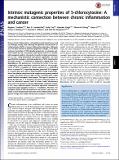| dc.contributor.author | Fedeles, Bogdan I. | |
| dc.contributor.author | Freudenthal, Bret D. | |
| dc.contributor.author | Yau, Emily | |
| dc.contributor.author | Singh, Vipender | |
| dc.contributor.author | Chang, Shiou-chi | |
| dc.contributor.author | Li, Deyu | |
| dc.contributor.author | Delaney, James C. | |
| dc.contributor.author | Wilson, Samuel H. | |
| dc.contributor.author | Essigmann, John M. | |
| dc.date.accessioned | 2016-03-02T16:51:06Z | |
| dc.date.available | 2016-03-02T16:51:06Z | |
| dc.date.issued | 2015-08 | |
| dc.date.submitted | 2015-04 | |
| dc.identifier.issn | 0027-8424 | |
| dc.identifier.issn | 1091-6490 | |
| dc.identifier.uri | http://hdl.handle.net/1721.1/101404 | |
| dc.description.abstract | During chronic inflammation, neutrophil-secreted hypochlorous acid can damage nearby cells inducing the genomic accumulation of 5-chlorocytosine (5ClC), a known inflammation biomarker. Although 5ClC has been shown to promote epigenetic changes, it has been unknown heretofore if 5ClC directly perpetrates a mutagenic outcome within the cell. The present work shows that 5ClC is intrinsically mutagenic, both in vitro and, at a level of a single molecule per cell, in vivo. Using biochemical and genetic approaches, we have quantified the mutagenic and toxic properties of 5ClC, showing that this lesion caused C→T transitions at frequencies ranging from 3–9% depending on the polymerase traversing the lesion. X-ray crystallographic studies provided a molecular basis for the mutagenicity of 5ClC; a snapshot of human polymerase β replicating across a primed 5ClC-containing template uncovered 5ClC engaged in a nascent base pair with an incoming dATP analog. Accommodation of the chlorine substituent in the template major groove enabled a unique interaction between 5ClC and the incoming dATP, which would facilitate mutagenic lesion bypass. The type of mutation induced by 5ClC, the C→T transition, has been previously shown to occur in substantial amounts both in tissues under inflammatory stress and in the genomes of many inflammation-associated cancers. In fact, many sequence-specific mutational signatures uncovered in sequenced cancer genomes feature C→T mutations. Therefore, the mutagenic ability of 5ClC documented in the present study may constitute a direct functional link between chronic inflammation and the genetic changes that enable and promote malignant transformation. | en_US |
| dc.description.sponsorship | National Institutes of Health (U.S.) (Grant P01 CA26731) | en_US |
| dc.description.sponsorship | National Institutes of Health (U.S.) (Grant R37 CA080024) | en_US |
| dc.description.sponsorship | National Institutes of Health (U.S.) (Center Grant P30 ES002109) | en_US |
| dc.language.iso | en_US | |
| dc.publisher | National Academy of Sciences (U.S.) | en_US |
| dc.relation.isversionof | http://dx.doi.org/10.1073/pnas.1507709112 | en_US |
| dc.rights | a | en_US |
| dc.source | National Academy of Sciences (U.S.) | en_US |
| dc.title | Intrinsic mutagenic properties of 5-chlorocytosine: A mechanistic connection between chronic inflammation and cancer | en_US |
| dc.type | Article | en_US |
| dc.identifier.citation | Fedeles, Bogdan I., Bret D. Freudenthal, Emily Yau, Vipender Singh, Shiou-chi Chang, Deyu Li, James C. Delaney, Samuel H. Wilson, and John M. Essigmann. “Intrinsic Mutagenic Properties of 5-Chlorocytosine: A Mechanistic Connection Between Chronic Inflammation and Cancer.” Proc Natl Acad Sci USA 112, no. 33 (August 4, 2015): E4571–E4580. | en_US |
| dc.contributor.department | Massachusetts Institute of Technology. Center for Environmental Health Sciences | en_US |
| dc.contributor.department | Massachusetts Institute of Technology. Department of Biological Engineering | en_US |
| dc.contributor.department | Massachusetts Institute of Technology. Department of Chemistry | en_US |
| dc.contributor.mitauthor | Fedeles, Bogdan I. | en_US |
| dc.contributor.mitauthor | Yau, Emily | en_US |
| dc.contributor.mitauthor | Singh, Vipender | en_US |
| dc.contributor.mitauthor | Chang, Shiou-chi | en_US |
| dc.contributor.mitauthor | Li, Deyu | en_US |
| dc.contributor.mitauthor | Delaney, James C. | en_US |
| dc.contributor.mitauthor | Essigmann, John M. | en_US |
| dc.relation.journal | Proceedings of the National Academy of Sciences | en_US |
| dc.eprint.version | Final published version | en_US |
| dc.type.uri | http://purl.org/eprint/type/JournalArticle | en_US |
| eprint.status | http://purl.org/eprint/status/PeerReviewed | en_US |
| dspace.orderedauthors | Fedeles, Bogdan I.; Freudenthal, Bret D.; Yau, Emily; Singh, Vipender; Chang, Shiou-chi; Li, Deyu; Delaney, James C.; Wilson, Samuel H.; Essigmann, John M. | en_US |
| dc.identifier.orcid | https://orcid.org/0000-0001-6159-0778 | |
| dc.identifier.orcid | https://orcid.org/0000-0002-8241-4834 | |
| dc.identifier.orcid | https://orcid.org/0000-0002-2196-5691 | |
| dc.identifier.orcid | https://orcid.org/0000-0002-2494-7763 | |
| mit.license | PUBLISHER_POLICY | en_US |
